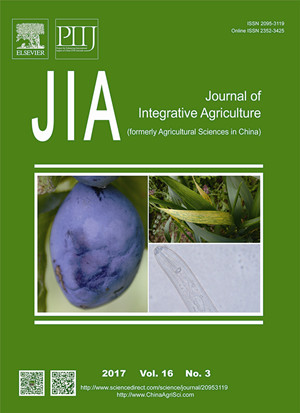|
|
The NAC-like transcription factor SiNAC110 in foxtail millet (Setaria italica L.) confers tolerance to drought and high salt stress through an ABA independent signaling pathway
XIE Li-na, CHEN Ming, MIN Dong-hong, FENG Lu, XU Zhao-shi, ZHOU Yong-bin, XU Dong-bei, LI Lian-cheng, MA You-zhi, ZHANG Xiao-hong
2017, 16(03):
559-571.
DOI: 10.1016/S2095-3119(16)61429-6
Foxtail millet (Setaria italica (L.) P. Beauv) is a naturally stress tolerant crop. Compared to other gramineous crops, it has relatively stronger drought and lower nutrition stress tolerance traits. To date, the scope of functional genomics research in foxtail millet (S. italic L.) has been quite limited. NAC (NAM, ATAF1/2 and CUC2)-like transcription factors are known to be involved in various biological processes, including abiotic stress responses. In our previous foxtail millet (S. italic L.) RNA seq analysis, we found that the expression of a NAC-like transcription factor, SiNAC110, could be induced by drought stress; additionally, other references have reported that SiNAC110 expression could be induced by abiotic stress. So, we here selected SiNAC110 for further characterization and functional analysis. First, the predicted SiNAC110 protein encoded indicated SiNAC110 has a conserved NAM (no apical meristem) domain between the 11–139 amino acid positions. Phylogenetic analysis then indicated that SiNAC110 belongs to subfamily III of the NAC gene family. Subcellular localization analysis revealed that the SiNAC110-GFP fusion protein was localized to the nucleus in Arabidopsis protoplasts. Gene expression profiling analysis indicated that expression of SiNAC110 was induced by dehydration, high salinity and other abiotic stresses. Gene functional analysis using SiNAC110 overexpressed Arabidopsis plants indicated that, under drought and high salt stress conditions, the seed germination rate, root length, root surface area, fresh weight, and dry weight of the SiNAC110 overexpressed lines were significantly higher than the wild type (WT), suggesting that the SiNAC110 overexpressed lines had enhanced tolerance to drought and high salt stresses. However, overexpression of SiNAC110 did not affect the sensitivity of SiNAC110 overexpressed lines to abscisic acid (ABA) treatment. Expression analysis of genes involved in proline synthesis, Na+/K+ transport, drought responses, and aqueous transport proteins were higher in the SiNAC110 overexpressed lines than in the WT, whereas expression of ABA-dependent pathway genes did not change. These results indicated that overexpression of SiNAC110 conferred tolerance to drought and high salt stresses, likely through influencing the regulation of proline biosynthesis, ion homeostasis and osmotic balance. Therefore SiNAC110 appears to function in the ABA-independent abiotic stress response pathway in plants.
|
